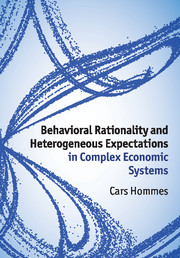Book contents
- Frontmatter
- Contents
- Figures
- Preface
- 1 Introduction
- 2 Bifurcations and chaos in 1-D systems
- 3 Bifurcations and strange attractors in 2-D systems
- 4 The nonlinear cobweb model
- 5 The cobweb model with heterogeneous expectations
- 6 An asset pricing model with heterogeneous beliefs
- 7 Empirical validation
- 8 Laboratory experiments
- Bibliography
- Index
7 - Empirical validation
Published online by Cambridge University Press: 05 February 2013
- Frontmatter
- Contents
- Figures
- Preface
- 1 Introduction
- 2 Bifurcations and chaos in 1-D systems
- 3 Bifurcations and strange attractors in 2-D systems
- 4 The nonlinear cobweb model
- 5 The cobweb model with heterogeneous expectations
- 6 An asset pricing model with heterogeneous beliefs
- 7 Empirical validation
- 8 Laboratory experiments
- Bibliography
- Index
Summary
In the previous chapters we have seen a number of stylized complexity models with heterogeneous expectations and heterogeneous trading strategies. What is the empirical relevance of heterogeneous expectations complexity models? In the last two chapters we discuss the empirical validation of heterogeneous expectations. In this chapter we discuss the empirical validity of the asset pricing model with heterogeneous beliefs compared to financial time series data, while the final chapter discusses the empirical relevance, both at the micro and at the macro level, of cobweb and asset pricing heuristic switching models in laboratory experiments with human subjects.
There is already a large literature on heterogeneous agent models (HAMs) replicating important stylized facts of financial time series on short time scales (say daily or higher frequency), such as fat tails and long memory in the returns distribution and clustered volatility. In fact, an important motivation to develop behavioral heterogeneous agent models has been the dissatisfaction with standard rational representative agent models to match stylized facts of financial time series. Many examples of heterogeneous agent models replicating stylized facts of financial markets have appeared in the literature, e.g., Brock and LeBaron (1996), Arthur et al. (1997b), Brock and Hommes (1997b), Youssefmir and Huberman (1997), LeBaron et al. (1999), Lux and Marchesi (1999, 2000), Farmer and Joshi (2002), Kirman and Teyssière (2002), Hommes (2002), Iori (2002), Cont and Bouchaud (2000) and Gaunersdorfer and Hommes (2007). The recent survey by Lux (2009) contains an extensive and stimulating survey of behavioral interacting agent models mimicking the stylized facts of asset returns with many more references; see also DeGrauwe and Grimaldi (2006) for an extensive discussion and applications in exchange rate modeling. In the stylized models discussed in this book, we have seen examples of simple heterogeneous agent models mimicking temporary bubbles and crashes and we have also discussed an endogenous mechanism for clustered volatility (either through intermittent chaos or through a co-existing stable steady state with a limit cycle or a more complicated attractor; see Subsection 6.6.3). In this chapter our focus will be whether observed bubbles and crashes in real markets can be explained by heterogeneous expectations models.
Information
- Type
- Chapter
- Information
- Publisher: Cambridge University PressPrint publication year: 2013
